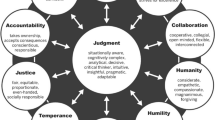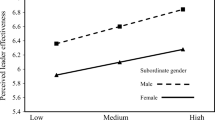Abstract
This study investigated the effects of sex and gender role characteristics on emergent leader effectiveness ratings in small task groups. Data were collected on two occasions from 122 subjects in 28 mixed-sex groups performing “sex-neutral” tasks for valued rewards over many weeks of interaction. Results showed that there were neither significant differences between effectiveness evaluations received by male and female leaders, nor among ratings received by leaders with masculine, feminine, or androgynous gender role orientations. However, individuals with androgynous gender role orientations gave significantly higher effectiveness evaluations than individuals with masculine or feminine gender role orientations.
Similar content being viewed by others
References
Banfield, E. E. Women in middle management positions: Characteristics, training, leadership style, limitations, rewards and problems. Dissertation Abstracts International, 1976, 37, 1952–1953.
Bass, B. M. Stogdill's handbook of leadership. New York: Free Press, 1981.
Bem, S. L. The measurement of psychological androgyny. Journal of Consulting and Clinical Psychology, 1974, 43, 155–162.
Bem, S. L. Sex role adaptability: One consequence of psychological androgyny. Journal of Personality and Social Psychology, 1975, 33, 634–643.
Bem, S. L., & Lenney, E. Sex-typing and the avoidance of cross-sex behavior. Journal of Personality and Social Psychology, 1976, 33, 48–54.
Deaux, K. From individual differences to social categories — Analysis of a decade's research on gender. American Psychologist, 1984, 39, 105–116.
Deaux, K. Sex and gender. Annual Review of Psychology, 1985, 36, 49–81.
Dobbins, G. H., & Platz, S. J. Sex differences in leadership: How real are they? Academy of Management Review, 1986, 11, 118–127.
Hollander, E. P. Women and leadership. In H. H. Blumberg & A. P. Hare (Eds.), Small groups and social interaction. London: Wiley, 1983.
Motowidlo, S. J. A scoring procedure for sex role orientation based on profile similarity indices. Educational and Psychological Measurement, 1981, 41, 735–745.
Orlofsky, J. L. Psychological androgyny, sex-typing and sex-role ideology as predictors of male-female interpersonal attraction. Sex Roles, 1982, 8, 1057–1073.
Orlofsky, J. L. Aslin, A. L., & Ginsburg, S. D. Differential effectiveness of two classification procedures on the Bem Sex Role Inventory. Journal of Personality Assessment, 1977, 41, 414–417.
Powell, G. N., & Butterfield, D. A. Sex, attributions and leadership: A brief review. Psychological Reports, 1979, 51, 1171–1174.
Sargent, A. G. The androgynous manager. New York: AMACOM, 1981.
Spence, J. T., Helmreich, R., & Stapp, J. Ratings of self and peers on sex role attributes and their relation to self-esteem and conceptions of masculinity and femininity. Journal of Personality and Social Psychology, 1975, 32, 29–39.
Stogdill, R. M. Handbook of leadership. New York: Free Press, 1974.
Yanico, B. BSRI scores: Stability over four years for college women. Psychology of Women Quarterly, 1985, 9, 277–283.
Author information
Authors and Affiliations
Rights and permissions
About this article
Cite this article
Goktepe, J.R., Schneier, C.E. Sex and gender effects in evaluating emergent leaders in small groups. Sex Roles 19, 29–36 (1988). https://doi.org/10.1007/BF00292461
Issue Date:
DOI: https://doi.org/10.1007/BF00292461




